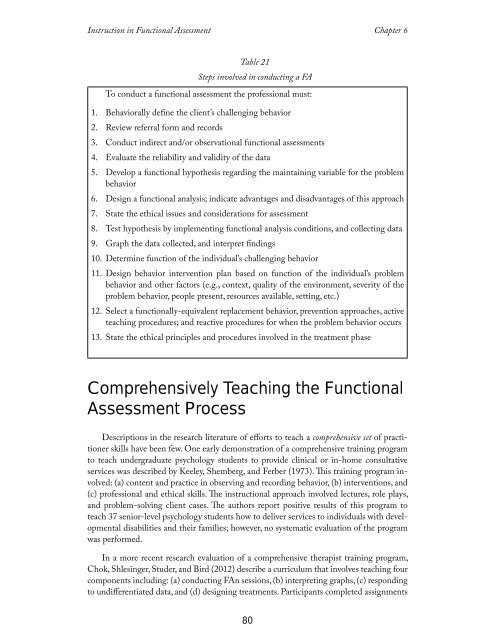Instruction in Functional Assessment, 2014a
Instruction in Functional Assessment, 2014a
Instruction in Functional Assessment, 2014a
You also want an ePaper? Increase the reach of your titles
YUMPU automatically turns print PDFs into web optimized ePapers that Google loves.
<strong>Instruction</strong> <strong>in</strong> <strong>Functional</strong> <strong>Assessment</strong> Chapter 6<br />
Table 21<br />
Steps <strong>in</strong>volved <strong>in</strong> conduct<strong>in</strong>g a FA<br />
To conduct a functional assessment the professional must:<br />
1. Behaviorally def<strong>in</strong>e the client’s challeng<strong>in</strong>g behavior<br />
2. Review referral form and records<br />
3. Conduct <strong>in</strong>direct and/or observational functional assessments<br />
4. Evaluate the reliability and validity of the data<br />
5. Develop a functional hypothesis regard<strong>in</strong>g the ma<strong>in</strong>ta<strong>in</strong><strong>in</strong>g variable for the problem<br />
behavior<br />
6. Design a functional analysis; <strong>in</strong>dicate advantages and disadvantages of this approach<br />
7. State the ethical issues and considerations for assessment<br />
8. Test hypothesis by implement<strong>in</strong>g functional analysis conditions, and collect<strong>in</strong>g data<br />
9. Graph the data collected, and <strong>in</strong>terpret f<strong>in</strong>d<strong>in</strong>gs<br />
10. Determ<strong>in</strong>e function of the <strong>in</strong>dividual’s challeng<strong>in</strong>g behavior<br />
11. Design behavior <strong>in</strong>tervention plan based on function of the <strong>in</strong>dividual’s problem<br />
behavior and other factors (e.g., context, quality of the environment, severity of the<br />
problem behavior, people present, resources available, sett<strong>in</strong>g, etc.)<br />
12. Select a functionally-equivalent replacement behavior, prevention approaches, active<br />
teach<strong>in</strong>g procedures; and reactive procedures for when the problem behavior occurs<br />
13. State the ethical pr<strong>in</strong>ciples and procedures <strong>in</strong>volved <strong>in</strong> the treatment phase<br />
Comprehensively Teach<strong>in</strong>g the <strong>Functional</strong><br />
<strong>Assessment</strong> Process<br />
Descriptions <strong>in</strong> the research literature of efforts to teach a comprehensive set of practitioner<br />
skills have been few. One early demonstration of a comprehensive tra<strong>in</strong><strong>in</strong>g program<br />
to teach undergraduate psychology students to provide cl<strong>in</strong>ical or <strong>in</strong>-home consultative<br />
services was described by Keeley, Shemberg, and Ferber (1973). This tra<strong>in</strong><strong>in</strong>g program <strong>in</strong>volved:<br />
(a) content and practice <strong>in</strong> observ<strong>in</strong>g and record<strong>in</strong>g behavior, (b) <strong>in</strong>terventions, and<br />
(c) professional and ethical skills. The <strong>in</strong>structional approach <strong>in</strong>volved lectures, role plays,<br />
and problem-solv<strong>in</strong>g client cases. The authors report positive results of this program to<br />
teach 37 senior-level psychology students how to deliver services to <strong>in</strong>dividuals with developmental<br />
disabilities and their families; however, no systematic evaluation of the program<br />
was performed.<br />
In a more recent research evaluation of a comprehensive therapist tra<strong>in</strong><strong>in</strong>g program,<br />
Chok, Shles<strong>in</strong>ger, Studer, and Bird (2012) describe a curriculum that <strong>in</strong>volves teach<strong>in</strong>g four<br />
components <strong>in</strong>clud<strong>in</strong>g: (a) conduct<strong>in</strong>g FAn sessions, (b) <strong>in</strong>terpret<strong>in</strong>g graphs, (c) respond<strong>in</strong>g<br />
to undifferentiated data, and (d) design<strong>in</strong>g treatments. Participants completed assignments<br />
80


















